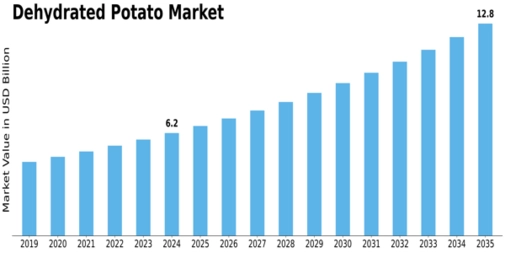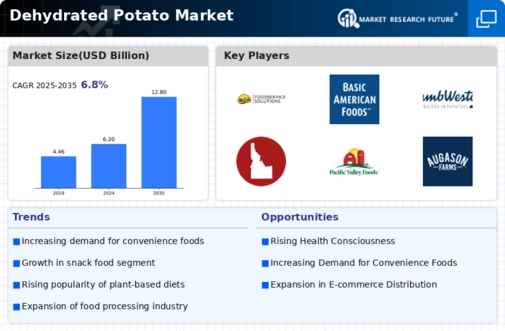Dehydrated Potato Size
Dehydrated Potato Market Growth Projections and Opportunities
The Dehydrated Potato Market is shaped by various factors that contribute to its growth and dynamics in the food industry. One of the primary drivers of this market is the convenience and versatility offered by dehydrated potatoes. As a convenient ingredient, dehydrated potatoes find extensive use in a variety of food products, including instant mashed potatoes, soups, snacks, and ready-to-eat meals. The dehydrated form allows for long shelf life, easy storage, and quick rehydration, making it a popular choice for both consumers and food manufacturers seeking efficiency and practicality in their culinary endeavors.
Consumer preferences and lifestyle changes play a significant role in shaping the Dehydrated Potato Market. With the increasing demand for time-saving and easy-to-prepare food options, dehydrated potatoes serve as a convenient solution for busy households. The market has responded by offering a range of dehydrated potato products, from flakes and granules to hash browns and potato crisps, catering to the diverse preferences and cooking habits of consumers who value convenience without compromising on taste.
Economic factors, including fluctuations in raw material prices and overall consumer spending, directly impact the Dehydrated Potato Market. The cost and availability of potatoes, the primary raw material for dehydrated potato products, influence the production costs and pricing of dehydrated potato offerings. Economic stability and increased disposable income may drive consumer willingness to purchase convenience food products like dehydrated potatoes, while economic downturns may lead to heightened price sensitivity and a shift towards more budget-friendly food options.
Supply chain considerations are pivotal in the Dehydrated Potato Market, particularly in terms of potato sourcing and processing. The availability and quality of potatoes, influenced by factors such as weather conditions and crop yields, impact the supply chain dynamics. Efficient processing and packaging are essential to preserve the quality and nutritional value of dehydrated potatoes, ensuring that the end products meet consumer expectations and adhere to industry standards.
Technological advancements in food processing and dehydration techniques contribute to the growth and innovation within the Dehydrated Potato Market. Advanced drying methods, such as freeze-drying and air drying, help retain the flavor, texture, and nutritional content of potatoes, enhancing the overall quality of dehydrated potato products. Additionally, technological innovations in packaging contribute to extended shelf life and improved product preservation, addressing the demand for convenience and sustainability in the food industry.
Health and wellness considerations are increasingly influencing the Dehydrated Potato Market. Consumers are becoming more conscious of their dietary choices and are seeking healthier alternatives, even in convenience foods. Some dehydrated potato products cater to this demand by offering low-sodium or salt-free options, and by promoting the natural and nutritious aspects of dehydrated potatoes. Brands are also responding to the demand for clean-label and minimally processed products, aligning with the health-conscious preferences of modern consumers.
Cultural preferences and global culinary influences contribute to the diverse product offerings within the Dehydrated Potato Market. Different regions have unique culinary traditions and preferences for potato-based dishes, influencing the types of dehydrated potato products available in those markets. From traditional potato dishes to innovative and globally inspired flavors, the market reflects a rich tapestry of options that cater to a wide range of tastes and preferences.











Leave a Comment